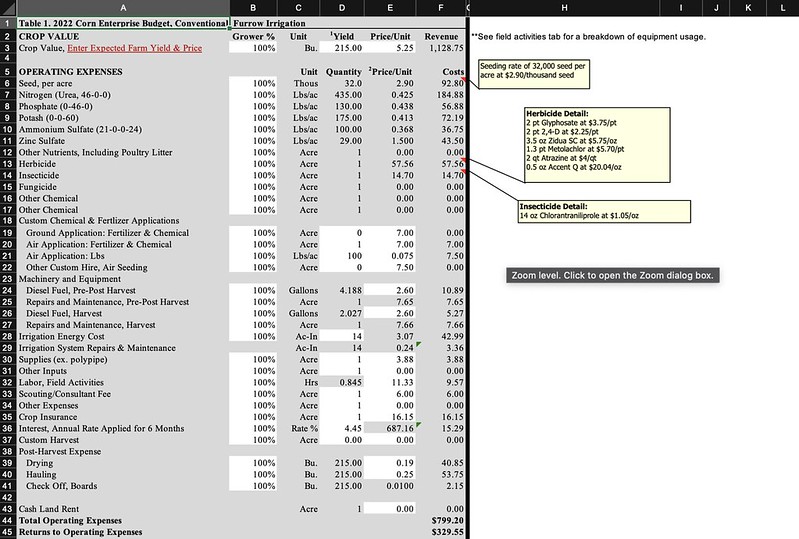2022 crop enterprise budgets now available online
Crop enterprise budgets for Arkansas to help farmers plan for the coming growing season
Dec. 22, 2021
By Ryan McGeeney
U of A System Division of Agriculture
Fast Facts:
- Crop budgets help growers determine input costs and profitability
- Updated 2022 budgets now available at https://bit.ly/2022-crop-budgets
(266 words)
(Newsrooms: With graphic at https://flic.kr/p/2mSvaTF)
LITTLE ROCK — The 2022 crop enterprise budgets from the University of Arkansas System Division of Agriculture are now available online at http://bit.ly/2022-crop-budgets.
The budgets, a set of planning tools popular with farmers, consultants and other agriculture industry professionals, help producers estimate inputs costs and potential profits for row crops, field crops and other commodities. They are developed and refined by agricultural economists with the Division of Agriculture.

FOR PLANNING PURPOSES -- A sample page from the enterprise crop budgets that Arkansas farmers can use to plan for the coming growing season. (U of A System Division of Agriculture image)
The interactive budgets allow growers to plan for crops under multiple irrigation scenarios, including use of surface irrigation, center pivot irrigation and no irrigation. The current roster of budgeted crops ranges from corn and cotton to soybeans and wheat, rice, peanuts, and grain.
Bobby Coats, retired extension economist for the Division of Agriculture, said the budgets are an essential tool in farmers’ decision-making process.
“There are three interactive decision aid spreadsheets, developed by Breana Watkins, that are simply excellent and compliment the individual enterprise budgets,” Coats said.
“I’ve focused on the producers’ decision-making process, but lenders, agricultural business, marketers and others use these budgets and decision aids,” he said. Coats now works for the Arkansas Department of Agriculture.
Interactive budgets premiered on the Division of Agriculture website in 2010, and have been repeatedly revised to reflect changes in research findings, verification programs, the federal Farm Bill and more.
The budgets also help users determine the amount of insurance coverage he or she may need to accommodate risk management objectives. The budgets are preloaded with standard expenses including seed, fertilizer, pesticide and fuel. As of 2015, the budgets can also be used to determine capitalization rates for estimating land values.
To learn about extension programs in Arkansas, contact your local Cooperative Extension Service agent or visit www.uaex.uada.edu. Follow us on Twitter and Instagram at @AR_Extension. To learn more about Division of Agriculture research, visit the Arkansas Agricultural Experiment Station website: https://aaes.uark.edu. Follow on Twitter at @ArkAgResearch. To learn more about the Division of Agriculture, visit https://uada.edu/. Follow us on Twitter at @AgInArk.
About the Division of Agriculture
The University of Arkansas System Division of Agriculture’s mission is to strengthen agriculture, communities, and families by connecting trusted research to the adoption of best practices. Through the Agricultural Experiment Station and the Cooperative Extension Service, the Division of Agriculture conducts research and extension work within the nation’s historic land grant education system.
The Division of Agriculture is one of 20 entities within the University of Arkansas System. It has offices in all 75 counties in Arkansas and faculty on five system campuses.
Pursuant to 7 CFR § 15.3, the University of Arkansas System Division of Agriculture offers all its Extension and Research programs and services (including employment) without regard to race, color, sex, national origin, religion, age, disability, marital or veteran status, genetic information, sexual preference, pregnancy or any other legally protected status, and is an equal opportunity institution.
# # #
Media contact: Ryan McGeeney
rmcgeeney@uada.edu
@Ryan_McG44
501-671-2120